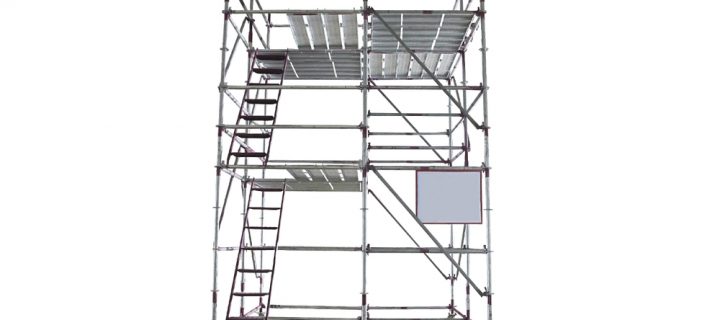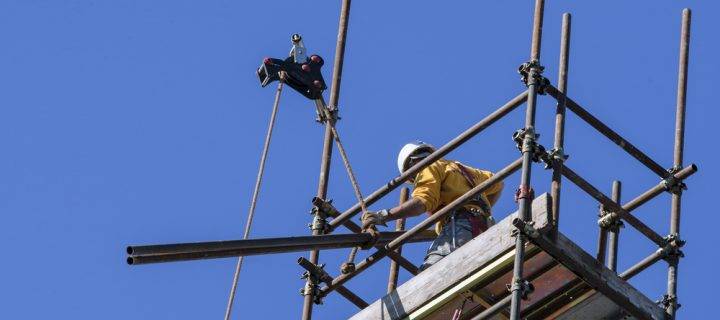Mobile alloy towers from Network Scaffold combine the best features of several other pieces of equipment that are designed for working at height. Mobile scaffold towers provide a minimal amount of added height and add stability that a conventional extension ladder does not. Also, stepladders can provide a stable platform to work on but lack the significant height that mobile towers provide. If you have never used a mobile access tower before, we have put together five reasons to make the change from conventional height access equipment in this blog. 5 Reasons to Choose Our Mobile Alloy Towers 1. Stability – One of the main reasons to consider a mobile scaffold tower is the stability they provide. Unlike two-legged ladders, mobile towers support themselves standing alone and do not need to be positioned against another structure to remain upright. A mobile tower can maintain stability even when a worker climbs up the access ladder or is working with tools on the working platform. Many mobile towers have additional support legs which can be fitted around the base to increase stability. The support legs act in the same way as extendable legs that are found on mobile cranes or cherry picker vans. Increasing the area of the mobile access tower’s base means the structure is less likely to become unbalanced or tip over when being used. 2. Adaptability – While mobile towers could look ungainly at first glance they are highly adaptable. Providing a safe platform for working at height, they can also be used in jobs both indoors and out. The working platform is surrounded by support bars on each side, allowing workers to carry out tasks on surfaces in front of them plus directly above them. Some mobile scaffold towers also fit together with a modular design, meaning extra height can be added if required. 3. Mobility – Mobility is one of the main reasons our clients choose mobile scaffold towers. Instead of assembling and disassembling a scaffold tower, mobile towers have wheels attached to each of their legs that make them more convenient for different scenarios. The wheels at the base of each leg can be locked and unlocked which allows workers to wheel the tower around...
Read Moreabout Why Should I Use a Mobile Alloy Tower?Alloy towers are one of the most important parts of our scaffolding services, but do you know how to erect them? For this blog, Network Scaffold will share our 12 step guide to erecting stairwell alloy towers. 12 Steps to Using Stairwell Alloy Towers Have two people available to erect all towers for safety reasons. Before the tower is erected you will need to ensure site conditions are safe. Operatives need to be competent and familiarise themselves with the manual for assembly. Sufficient equipment also needs to be available to erect the tower at the height required whilst checking components are not damaged or incompatible plus checking the tower breakdown. Insert the adjustable legs and baseplates into the opening base ladder frames. Place the two ladder frames on the staircase in the position required, roughly 1.5 metres apart with the baseplates fully located on the steps of the staircase with the offset plate facing inwards towards the centre of the frame. Connect the two bottom rungs of the frames using a diagonal brace. The brace hooks should be located at the centre of the bottom rungs of the ladder frames which prevents clashing using an erection platform. Level the frames by turning the adjustable leg nuts so that the bottom rung of the frame on the upper step is at the same level as the top rung of the frame on the lower steps with the adjustable legs extended if necessary to achieve this. Fit a trapdoor platform with the trapdoor end located at the lower part of the stairs, to the bottom rung of the frame on the upper step and to the top rung of the ladder frame on the lower step. Make sure the platform is level. There is a small bubble level on the underside of all stair deck alloy towers to ease levelling. This platform will be used for the temporarily safe erection of the tower and will be removed later when being used further up the tower. From the bottom of the staircase, fit a six rung upper frame to the top of the ladder frame on the lower step. Lock the frames together with the interlock clips. Climb into the middle of...
Read Moreabout How to Erect Stairwell Alloy TowersAlloy towers hold many advantages over ladders for jobs that need completing around homes or in the garden. Network Scaffold is the leading supplier of scaffolding and scaffold towers across Derbyshire, which is why we have put together five reasons you should be choosing them every time. Five Reasons to Use Scaffold Towers 1. Safety – Scaffolding towers are much safer than ladders, as they have a wider surface area plus they are supported on four legs making them free-standing. Ladders, on the other hand, are on two legs and rest at an angle. Ensuring you have a flat platform to work on is much more stable and do not have to worry about falling off a ladder that could wobble and requires closer supervision and care when in use. Safety is the top priority for scaffold towers and is made clear from erecting the scaffold to dismantling it. 2. The Platform – The platform on alloy towers allows you to move around more freely and have your tools and equipment close by, plus you can leave it in place for longer. Eliminating the hassle of moving ladders, using a tower will prove a great time saver. The structures platform reduces the need for accompanying assistance, whereas with a ladder you will need someone at the base to make sure it is secure. Platforms are also equipped with bars or guide rails to prevent users from falling off, which enhances its safety. 3. Easy to Work On – Alloy towers make jobs such as painting and de-guttering quite straightforward, helping you gain access to difficult to reach areas. The ability to work more easily means that work will be completed faster. Ladders are useful for smaller tasks, but if you need a more robust and professional piece of equipment then scaffold towers are the best choice. 4. Straightforward to Manoeuvre – Scaffold towers are usually equipped with wheels, which allows users to change the location of the tower easily, compared to cumbersome ladders. Whilst moving a tower you should always reduce the height to no higher than 4 metres. Before moving the tower ensure the ground is stable and there are no risks to the tower or the user...
Read Moreabout Choosing Scaffold Towers Instead of a Ladder


